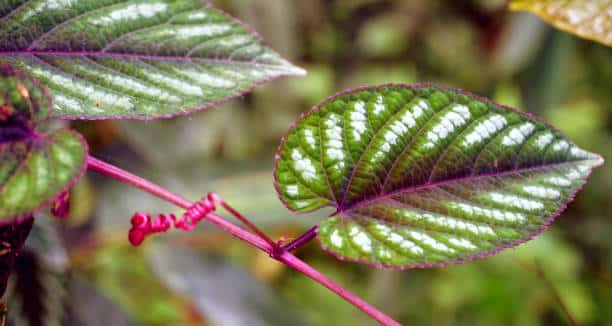Cissus Discolor, also known as the Rex Begonia Vine, is a captivating houseplant known for its dramatic foliage. This stunning plant, native to Southeast Asia, is a member of the grape family, Vitaceae. Its enchanting leaves, marked by striking green and silver patterns on the top and a royal purple underneath, make it a popular choice for indoor gardeners seeking to add a tropical touch to their collection.
Understanding the Growth Habits of Cissus Discolor
Growth and Structure
Cissus Discolor is a fast-growing climbing vine that thrives when provided a structure to latch onto, like a trellis or a moss pole. The plant’s unique leaves, elliptical in shape, can grow up to 4 inches long and showcase an iridescent surface that catches light beautifully.
Seasonal Changes
Like many tropical plants, the Cissus Discolor undergoes seasonal changes. In the growing season of spring and summer, it flourishes and grows rapidly, while in the fall and winter, growth slows. During these colder months, it’s crucial to adjust care accordingly to ensure the plant’s health.
Essential Care Tips for Cissus Discolor
Light Requirements
Cissus Discolor prefers bright, indirect light. While it can tolerate lower light conditions, its vibrant coloration and growth rate are best maintained with ample light exposure. However, harsh, direct sunlight can scorch the leaves, leading to irreversible damage.
Watering Needs
This plant prefers evenly moist soil. However, it’s vital to avoid waterlogging as it can lead to root rot. In the growing season, watering should be more frequent, while in the colder months, reduce watering to allow the soil to partially dry out between watering sessions.
Temperature and Humidity
Cissus Discolor thrives in warmer temperatures, ideally between 65°F and 85°F. The plant is not frost tolerant and can suffer if exposed to temperatures below 60°F. High humidity is also crucial for the plant’s health, emulating its native tropical environment. This can be achieved by using a humidifier, placing the plant on a pebble tray filled with water, or regular misting.
Feeding and Pruning Cissus Discolor
Fertilizer Requirements
Cissus Discolor benefits from regular feeding during the growing season. Use a balanced houseplant fertilizer diluted to half strength, applied every two weeks. In the dormant winter months, cease feeding as the plant’s nutrient requirements decrease.
Pruning Practices
Pruning is essential for maintaining the health and aesthetics of your Cissus Discolor. Regularly prune to encourage bushier growth and to keep the plant looking its best. Always make sure to use clean, sharp tools to prevent the spread of disease.
Common Problems and Solutions for Cissus Discolor
Despite its exotic appeal, Cissus Discolor is not without its challenges. Common issues include leaf drop, which can be caused by overwatering, cold drafts, or inadequate light. Similarly, yellowing leaves can indicate overwatering or poor drainage. If you notice these symptoms, reassess your care routine and make necessary adjustments.
On the other hand, pests can also pose a threat. Mealybugs and spider mites are common culprits that can be managed with insecticidal soap or neem oil.
Propagating Cissus Discolor

Cissus Discolor can be easily propagated, allowing you to grow more stunning plants for your collection or to share with friends. The most popular method is stem cutting propagation.
Stem Cutting Propagation
- Choose a healthy stem with at least two or three leaves, ideally during the growing season.
- Using a clean, sharp pair of scissors or pruning shears, cut the stem just below a leaf node.
- Remove the bottom leaves from the cutting, leaving only the topmost leaves intact.
- Place the cutting in a glass of water, ensuring that the bottom nodes are submerged. Make sure no leaves are submerged to prevent rot.
- Place the glass in a warm location with bright, indirect light.
- Change the water every few days to keep it fresh and to prevent bacterial growth.
- After several weeks, roots should start to form. Once the roots are at least an inch long, the cutting is ready to be potted.
- Plant the cutting in a well-draining potting mix, and care for it as you would a mature Cissus Discolor.
Repotting Your Cissus Discolor
Cissus Discolor will need repotting every 2-3 years, as it can quickly outgrow its container. Choose a pot that is slightly larger than the current one, with proper drainage holes. The ideal time to repot is during the spring or early summer, when the plant is actively growing.
Repotting Steps
- Carefully remove the plant from its current pot, preserving as much of the root system as possible.
- Examine the roots for signs of disease or damage, and trim away any unhealthy sections.
- Prepare the new pot by adding a layer of well-draining potting mix at the bottom.
- Place the plant in the new pot, ensuring that the top of the root ball is at the same level as it was in the previous pot.
- Fill in the gaps around the root ball with fresh potting mix, gently tamping it down to eliminate air pockets.
- Water the plant thoroughly to help it settle into its new home.
Conclusion
Cissus Discolor is a striking houseplant that can bring a touch of the tropics to your indoor garden. With the proper care, this eye-catching plant will reward you with lush, vibrant foliage and rapid growth. By mastering the care secrets of Cissus Discolor, you’ll be well on your way to cultivating a stunning specimen that is sure to impress.

